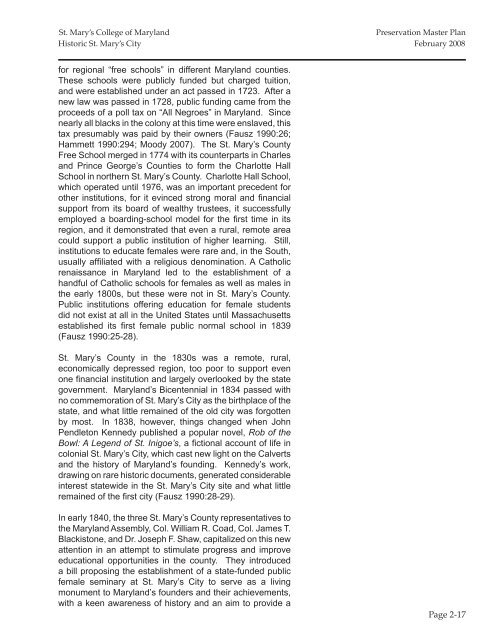St. Mary's College of Maryland Preservation Master Plan
St. Mary's College of Maryland Preservation Master Plan
St. Mary's College of Maryland Preservation Master Plan
- No tags were found...
You also want an ePaper? Increase the reach of your titles
YUMPU automatically turns print PDFs into web optimized ePapers that Google loves.
<strong>St</strong>. Mary’s <strong>College</strong> <strong>of</strong> <strong>Maryland</strong><strong>Preservation</strong> <strong>Master</strong> <strong>Plan</strong>Historic <strong>St</strong>. Mary’s City February 2008for regional “free schools” in different <strong>Maryland</strong> counties.These schools were publicly funded but charged tuition,and were established under an act passed in 1723. After anew law was passed in 1728, public funding came from theproceeds <strong>of</strong> a poll tax on “All Negroes” in <strong>Maryland</strong>. Sincenearly all blacks in the colony at this time were enslaved, thistax presumably was paid by their owners (Fausz 1990:26;Hammett 1990:294; Moody 2007). The <strong>St</strong>. Mary’s CountyFree School merged in 1774 with its counterparts in Charlesand Prince George’s Counties to form the Charlotte HallSchool in northern <strong>St</strong>. Mary’s County. Charlotte Hall School,which operated until 1976, was an important precedent forother institutions, for it evinced strong moral and financialsupport from its board <strong>of</strong> wealthy trustees, it successfullyemployed a boarding-school model for the first time in itsregion, and it demonstrated that even a rural, remote areacould support a public institution <strong>of</strong> higher learning. <strong>St</strong>ill,institutions to educate females were rare and, in the South,usually affiliated with a religious denomination. A Catholicrenaissance in <strong>Maryland</strong> led to the establishment <strong>of</strong> ahandful <strong>of</strong> Catholic schools for females as well as males inthe early 1800s, but these were not in <strong>St</strong>. Mary’s County.Public institutions <strong>of</strong>fering education for female studentsdid not exist at all in the United <strong>St</strong>ates until Massachusettsestablished its first female public normal school in 1839(Fausz 1990:25-28).<strong>St</strong>. Mary’s County in the 1830s was a remote, rural,economically depressed region, too poor to support evenone financial institution and largely overlooked by the stategovernment. <strong>Maryland</strong>’s Bicentennial in 1834 passed withno commemoration <strong>of</strong> <strong>St</strong>. Mary’s City as the birthplace <strong>of</strong> thestate, and what little remained <strong>of</strong> the old city was forgottenby most. In 1838, however, things changed when JohnPendleton Kennedy published a popular novel, Rob <strong>of</strong> theBowl: A Legend <strong>of</strong> <strong>St</strong>. Inigoe’s, a fictional account <strong>of</strong> life incolonial <strong>St</strong>. Mary’s City, which cast new light on the Calvertsand the history <strong>of</strong> <strong>Maryland</strong>’s founding. Kennedy’s work,drawing on rare historic documents, generated considerableinterest statewide in the <strong>St</strong>. Mary’s City site and what littleremained <strong>of</strong> the first city (Fausz 1990:28-29).In early 1840, the three <strong>St</strong>. Mary’s County representatives tothe <strong>Maryland</strong> Assembly, Col. William R. Coad, Col. James T.Blackistone, and Dr. Joseph F. Shaw, capitalized on this newattention in an attempt to stimulate progress and improveeducational opportunities in the county. They introduceda bill proposing the establishment <strong>of</strong> a state-funded publicfemale seminary at <strong>St</strong>. Mary’s City to serve as a livingmonument to <strong>Maryland</strong>’s founders and their achievements,with a keen awareness <strong>of</strong> history and an aim to provide aPage 2-17
















